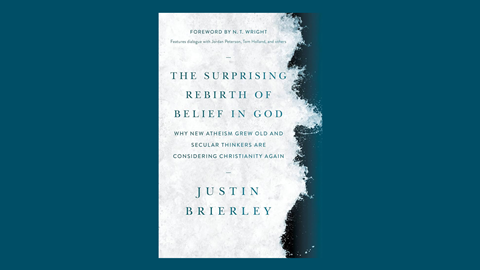Justin Brierley’s “The Surprising Rebirth of Belief in God” explores the unexpected comeback of faith in our culture, examining new data, cultural shifts, and the unique opportunities and challenges for Christians as spiritual curiosity surges once more.
Justin Brierley opens his excellent book “The Surprising Rebirth of Belief in God” with Matthew Arnold’s 1867 poem, Dover Beach, which laments the receding sea of faith occasioned by the rise of modernism. Brierley, however, sparks a note of optimism by suggesting that the tide may be turning. His modest hunch that “we might yet see the tide of faith come rushing back in again within our lifetime” has quickly become a hypothesis confirmed by wave after wave of data. The speed of its return has surpassed Brierley’s surprise at seeing a ripple on the horizon, and his hope of one day dipping his toes in it has been joyfully replaced by finding himself knee-deep in its waters.
Bible sales are increasing and not just in the UK but in the USA aswell. Church attendance is rising. The “none of the above” demographic has plateaued. Colleges such as Asbury are experiencing revivals. Athletes are increasingly thanking God and Jesus in post-game interviews. Interest in faith-based films is growing. Religious polling, such as The Bible Society’s “Quiet Revival Study,” reveals increased interest and participation in religious institutions. Even atheists who hopped on the “There is probably no God” bus couldn’t enjoy the ride because they worried about what the world would look like when they got off at the next stop.
Brierley spent over 17 years hosting the Premier Unbelievable? podcast, wading through tide pools of skepticism with his apologist friends, hoping to convince his atheist guests that the waters they enjoyed splashing around in were courtesy of the sea of faith. While many Christians were reluctant to give atheists a platform, Brierley not only gave them a voice but also invited their most eloquent spokespeople to take their best shot. Atheists naturally accepted the invitations, believing it would be like shooting fish in a barrel, but soon found themselves deep-sea fishing with experienced Christian anglers. Unfortunately, their Christian armor-piercing arguments backfired and became apologetic ammunition for Jesus. Many of these misfirings were documented in a series of Christian conversion essays collected by Alistair McGrath in his book, “Coming to Faith through Richard Dawkins.”
Pregnant with possibility
In his excellent new book “Believe,” New York Times columnist Ross Douthat makes the case that belief in the supernatural, numinous, and transcendent is a logical, time-tested, and intuitively appropriate response to the world around us. While not explicitly addressing the identity of Brierley’s reborn God, he points out that the world is pregnant with spiritual possibility. Douthat’s book provides us with the prenatal ultrasound of a world spiritually gestating, while Brierley is in the maternity ward recording the cries of the newly Reborn.
What do Douthat’s “pregnancy of belief” and Brierley’s “rebirth of God” tell us about the rising rates of faith fertility? Is it merely postmodern permission to dispense with our modernist contraceptives and be spiritually promiscuous, or is it a planned religious pregnancy spawned by a reawakening of the dormant human desire to be in the family way?
Flotsam and Jetsam
We can get excited about the returning tide of faith that floats our spiritual boats, but we must remember that it also brings its share of flotsam and jetsam, which we must navigate cautiously. While the signs are encouraging for Christianity, we need to ask ourselves if this rebirth is merely cultural permission to be spiritual. The data suggests that while people check out of traditional faith, they have remained spiritual but practice it in unorthodox ways. Young people have shown increased interest in New Age religious practices involving crystals, spells, and tarot cards. Islam is on the rise, especially in Europe, and Buddhism and Hinduism are similarly displaying signs of increased interest. This question is crucial because we need to know if our Christian witness represents an apologetic success or an apologetic opportunity. Do we pat ourselves on the back for a job well done, or do we send out more laborers because the harvest is more plentiful than ever?
Read more:
Dawkins the Apologist
The richer meaning within a Christian vision for the future
How should we respond to church scandal?
What the Church can offer someone suffering with depression
Metamodern turn
I think it’s reasonable to view Matthew Arnold’s tide as the philosophical milieu upon which all religion floats—a milieu defined by its relationship to the supernatural. Premodernism was a spiritual high tide where everyone needed a religious boat to prevent drowning. Modernism represented a low tide where all boats were stuck in the sand, and people frustrated by their inability to go anywhere abandoned ship. Postmodernism noted swells on the horizon, inspiring them to wax their new age boards and surf the spiritual waves. However, we now appear to have reached a metamodern high tide where boogie boards are inadequate for the journey, and religious surfers are trading them in for ships that have proven to be historically sea-worthy.
Metamodernism represents the Hegelian synthesis of the modern desire for structure and the postmodern inclination to deconstruct. It embodies a combination of modernist utopian dreams and postmodern dystopian fears. Neuroscientist Anne-Laure Le Cunff describes metamodernism this way:
“A common image used to describe metamodernism is that of a pendulum, constantly oscillating between creation and destruction, hope and doubt, optimism and realism. (Anne-Laure Le Cunff)
It is a cultural moment ripe for religious revival, as people are once again interested in the stability of authority, provided it is pursued cautiously, and are exhausted by the Sturm und Drang of nihilism and have allowed themselves to be tentatively hopeful that they can find joy.
I believe the metamodern mood may contribute to Brierley’s rebirth because it allows the materialist to contemplate mystery, and the relativist to consider a unifying narrative. It explains why secular thinkers like Douglas Murray, Jordan Peterson, and Tom Holland can make Christian withdrawals without depositing anything in the heavenly treasury. It also explains why an ardent atheist like Richard Dawkins can wear his cultural Christianity on his sleeve, not as an acknowledgment that Jesus died for his sins, but as an amulet to ward off Islam. The problem for these men is that you can’t sustain cultural Christianity without Christ. You can’t build your house on Christian bedrock if you remove the Cornerstone.
Metamodernism has made attending God’s rebirth fashionable without the need to pay child support. However, it seems that the longer people admire this Newborn, the more they recognize an image resembling an incarnation they once believed was merely an old wives’ tale.
Dog Tired
Humans cannot live without an overarching story. Modernism provided us with a tedious lecture. Postmodernism presented us with stream of consciousness. Metamodernism offered us a useful fiction. However, it now appears that we are witnessing a renewed interest in the greatest story ever told.
Modernity and postmodernity were initially developed in ivory towers and promoted by academics who overlooked potential safety concerns while urging the public to take their ideas for a test drive. Unfortunately, road testing led to a series of cultural collisions, prompting people to reject their role as philosophical crash test dummies and instead return to the religious dealership in search of a quality-engineered vehicle like Christianity.
The modernist experiment of life without God left us feeling empty. The postmodern filling of that space with a plethora of Build-A-Bear gods left us overwhelmed. As it turns out, people are dissatisfied with both a lack of choice and endless choice, and would rather be chosen. The relentless pursuit of God has left them dog-tired, and they are now surrendering to the Hound of Heaven.
Get access to exclusive bonus content & updates: register & sign up to the Premier Unbelievable? newsletter!
Baby or bathwater
One of the concerns Brierley addresses in the second season of his “Surprising Rebirth” podcast series is whether this embrace of religion reflects a renewed belief in God or serves merely as a bumper sticker on a car promoting a political party or a tattoo on a well-defined bicep promoting a muscular Christianity. I worry that he may be correct and that, in certain circles, we are tossing out the baby Jesus while splashing around in the soiled religious bath water.
What’s interesting about rebirth as a metaphor is that it conjures up images of a baby in the buff. It makes us step back and ponder God’s naked truth, which is essential because it isn’t God’s birthday suit that creates the religious problem but how we clothe Him after we bring Him home. The beauty of Christianity is that it reveals a God who entered our world as a naked newborn in a manger and left it naked hanging on a cross. His incarnation and death reveal His true nature, so we mustn’t cover them up just because we might get embarrassed.
Premodern two cents worth
Interestingly, metamodernism not only facilitates a dialogue between modernism and postmodernism but also invites premodernity to toss in its two cents’ worth. We are witnessing a renewed interest in older religious traditions such as Roman Catholicism and Eastern Orthodoxy because they combine authority, which appeals to the modernist, with a broad, mystical tent that intrigues the postmodernist. Interestingly, this reborn God, rather than having skin as soft as a baby’s bottom, is covered in wrinkles.
Keeping it weird
One of the three areas Brierley recommends the church focus on as it moves forward in the postpartum period is keeping Christianity weird, quoting a phrase attributed to historian Tom Holland. In a public conversation, when asked about the Church’s role in contemporary society, Holland advised: “Let Christianity be weird.” Christianity checks the weirdness boxes by declaring it is better to be humble than prideful, weak than strong, and sacrificial than self-serving. It is weird because it believes the archetypal became typical, myth became fact, and God became man. Jesus should consistently serve as a counterpoint to the ways of the world; if our faith conforms to cultural norms, it ceases to be Christian.
Conclusion
Douthat observed that his “unhappy agnostic correspondents” were intrigued by the returning spiritual tide but wanted to understand the gravitational force behind the gently lapping waves.
“The spiritual and supernatural never really go away, and already the time of the new atheism is passing; already mystery and magic and enchantment seem to be rushing back into the world…But everywhere mysticism is on the march, spiritual experimentation is coming back, my unhappily agnostic correspondents are on the hunt for gnosis—the divine experience, the hidden architecture, the secret truth.” (Ross Douthat – Believe)
We can rejoice that the tide of faith has returned, but it will continue to take the shape of water unless we find a suitable religious receptacle to contain it. Christians excel in this regard because, while admitting that they are broken jars of clay, they nonetheless fiercely hold on to every drop, determined to bring Living Water to a world dying of thirst.
“I saw the blood coming from one of His hands, and I felt terribly sad to think that it was falling to the earth and that no one was rushing forward to catch it. I determined to stay at the foot of the Cross and receive it. I knew that I should then have to spread it among other souls. The cry of Jesus on the Cross - “I am thirsty” - rang continually in my heart and set me burning with a new intense longing. I wanted to quench the thirst of my Well-beloved and I myself was consumed with a thirst for souls.” (Therese of Lisieux)
Erik Strandness is a physician and Christian apologist who practiced neonatal medicine for more than 20 years and has written three apologetic books. Information about his books can be found at godsscreenplay.com
























